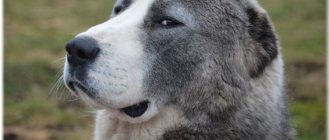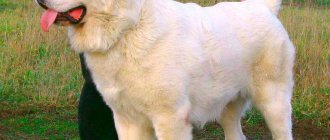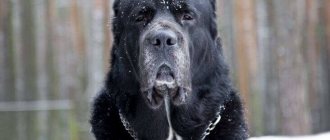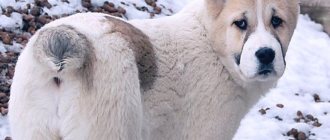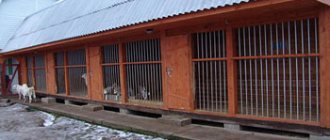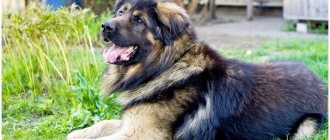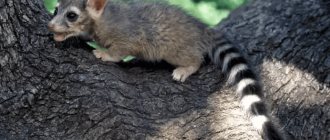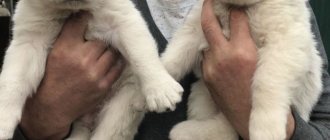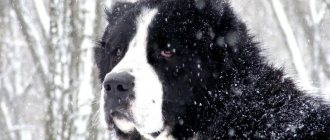Photo: Alabai
Alabai or Central Asian Shepherd Dog (CAO) is one of the oldest breeds, historical information about which is closely intertwined with the issue of natural selection. The ancestors of Central Asian shepherds, mastiffs, were tamed by people who inhabited the territory of modern Central Asia a long time ago - from three to six thousand years ago.
- Life expectancy: from 12 to 15 years;
- Country: USSR;
- Height (male): 65 - 78 cm;
- Height (female): 60 - 69 cm;
- Weight (male): 50 - 79 kg,
- Weight (female): 40 - 65 kg;
- Color: brown; grey; white; ginger; brindle; pale yellow; piebald; tricolor;
- 2 types of coat: long (7-8 cm) and short (3-4 cm), smooth.
- ICF classification: No. 355; 2nd group; 2nd section (Molossians; mountain dogs).
Historical information about the breed
The peoples living in Central Asia were actively engaged in nomadic cattle breeding, for this reason specific characteristics in dogs were important to them. Thus, the dog had to guard livestock, assist a person on a hunt, cope with enemy attacks, and show strength, courage and endurance.
The qualities described above were very highly valued in dogs at that time. There is historical information according to which, during the reign of the khans, increased attention was paid to the issue of dog breeding. Each dog had a specially trained person who looked after it. In total, the livestock traditionally consisted of about ten thousand dogs; the breeding of these animals was strictly controlled by the khan's brothers.
For many centuries, only the best representatives of the class were selected as shepherds. Those who were cowardly, weak or overly aggressive were disposed of without regret.
Photo: Alabai dog. Central asian shepherd dog
The ideal representative of the species that they sought to breed should have a peaceful disposition towards people (Asians are used to moving freely between their huts, without showing aggression towards people and children). The main task that was set before them was to prevent strangers and predatory animals from accessing the flocks of animals, as well as to protect the property of their owners. Young children and representatives of the fairer sex could easily be left in charge of the Central Asian Shepherd when the male population left the village, going hunting or fighting enemies.
We can confidently say that there was a kind of folk selection that had even higher and more stringent requirements than those that the breeders of our time set for themselves.
The Alabai dog is a shepherd dog bred for real life; it was able to successfully pass natural selection and become a loyal friend and guardian of property.
The territory of Central Asia was inhabited by a large number of different nationalities, each giving its own names to breeding animals. Therefore, today you can find different variations of the name of representatives of this species.
Its official name is the Central Asian Shepherd Dog, and it is under this name that it is registered in the Russian Cynological Association and in the FCI. However, unofficially this dog is also called the Turkmen Alabai and the Kazakh wolfhound.
Photo: Alabai. Central asian shepherd dog
By and large, there is no significant difference in how you call the representatives of the described breed, the main thing is that it has the same standard, which corresponds to the description of the Central Asian Shepherd Dog. If you hear a version that the Kazakh wolfhound is a new version of the breed, the seller probably does not have reliable information or is quite deliberately trying to confuse you.
In general, it cannot be unequivocally stated that the Alabai dog breed is the fruit of the creation of one specific Asian nationality. After all, the territory of Central Asia is huge, it contains a large number of different states, the nationalities that lived in them earlier actively bred guard and shepherd dogs, which today are known as wolfhounds.
Would you like to delve into the history and create a short family tree of the breed? Its base will be represented by ancient mastiffs, the trunk - by wolfhounds, and one of the branches will be firmly occupied by the Central Asian Shepherd Dog. The neighboring branches are represented by close relatives of the Alabai: Mongolian and Caucasian Shepherds, Tibetan and Spanish Matiffs.
Scientists of the Soviet Union actively worked to improve this breed, starting in the 30s of the 20th century. Officially, the Central Asian Shepherd Dog was recognized by experts of the International Canine Association only in 1989.
Nutrition
The Alabai Shepherd Dog eats in the same way as other large breeds. The basis of the diet is protein products. It is important that the protein is of animal origin. It is found in meat and some types of fish.
It is preferable to give lean meats such as beef and veal, and sea and ocean fish are acceptable. Chicken should be treated with caution. It is better to peel it and separate it from the bones.
Bones, especially tubular ones, are prohibited. From time to time, pure meat can be replaced with offal. Pork is best avoided due to its high fat content. You can prepare soups for your dog with the addition of cereals and vegetables.
But the single volume of feed should not exceed two liters. Suitable cereals include buckwheat, rice and sometimes oatmeal. Vegetables can be given raw or boiled. Carrots, cabbage, zucchini, pumpkin and greens, as well as tomatoes and cucumbers, are acceptable. You should not spoil your dog with potatoes.
Dry foods are considered an alternative way to eat. Its advantage is its balance and inclusion of minerals and other important elements for harmonious development and maintenance of health.
In addition, such food does not require additional cooking, steaming, etc. Alabai puppies receive dry food , then the pieces are soaked in water until the dog replaces its milk teeth with molars.
In the case of an adult dog, this manipulation is irrelevant. By the way, animals that have reached one year old can easily eat twice a day. Babies require more frequent and smaller feedings. But at the same time, their portions are smaller.
Very little babies feed on mother's milk. But if maternal food is given on demand, then feeding from a bowl should be carried out strictly according to the schedule, and the first meal should be no earlier than 7.00, and the last one no later than 19.00.
Alabai: breed characteristics
The Alabai dog has a rather interesting standard, primarily because representatives of this species cannot be classified according to certain criteria. Based on the region of origin of the animal, the Central Asian Shepherd has certain features that are not inherent in other representatives of the same breed. Therefore, even cynology specialists tend to distinguish different types of Asians in one standard:
- Turkmen Asians are distinguished by their strength and endurance, as well as their large size, but fairly proportional physique. They tend to react quickly to surrounding stimuli, have low sensitivity to pain, and are very intelligent.
- Tajik Asians - they are characterized by a heavier body constitution, act as St. Bernard-like dogs that have a longer coat.
- Uzbek Asians are characterized by great heterogeneity, but generally representatives of this species are distinguished by their small stature, lighter body constitution, and also do not show such courage as their previous brothers.
- Kazakh Asians - they were also able to preserve the characteristic features of the Alabai breed, but in the northern regions you can find a large number of mestizos who are not as outstanding in size and not as courageous in character as the previous versions.
People who are not very well versed in this dog breed tend to confuse it with Caucasian Shepherds, Moscow Watchdogs or even St. Bernards. But the Alabai Shepherd Dog has its own characteristic features, with the help of which it is quite easy to establish that what you see in front of you is the very famous Alabai, a representative of Asia.
Photo: Alabai. Central asian shepherd dog
The first documented description of this breed was the work of Professor S.N. Bogolyubsky, written by him in 1926. After this, in 1931, the CAO standard was adopted, to which many additions and changes were subsequently made. At this time, the latest edition of the breed was adopted in 2003.
The animal has a moderately stretched format and is distinguished by its streamlined shape. The best impression of the appearance of the Central Asian Shepherd will be the words of the shepherds: “They were made this way by the wind.” Indeed, in reality, if you close your eyes to its massive size, the Alabai looks like a rude, clumsy lump. It is distinguished by its proportional build, the movements of the animal are harmonious and swift. It has voluminous muscles, but lacks any special relief. The skin is quite thick and elastic.
The lower limits of Alabai growth: for males - from seventy centimeters, for females - from sixty-five centimeters. The forelimbs in length occupy approximately one second of the animal's height. Bitches have a more elongated body. It is greatly appreciated when the dog is larger in stature, but it is important that it maintains a fairly proportionate physique.
The Alabai Shepherd has a massive head, similar in shape to a triangle. There is a smooth transition from the line of the forehead to the muzzle, but thanks to the pronounced brow ridges they look quite sharp. The animal has a massive muzzle, which almost does not taper towards the nose, thick lips, the upper part of which covers the jaw.
The jaws are large, wide, and have large white teeth. On a massive neck you can see the presence of a dewlap.
The hind legs are straight, stand parallel, and have well-developed muscles. The animal moves very smoothly, like a cat. Characteristic movement is trotting, when pushing off with the help of the hind limbs and freely extending them with a forward swing of the front paws.
Alabai is distinguished by its thick coat. According to the standard, exceptions may be allowed in the form of animals with a short coat of tightly fitting hair, as well as a length of up to ten centimeters, when it forms a mane, a fluffy tail with pants, and there are fringes behind the ears.
There are many color options, with the exception of blue and brown.
When an Alabai puppy is born, during the first days his ears are cropped, but this requirement is not mandatory. Even if the ears and tail are not docked, this will not be a disadvantage during exhibitions. The presence of congenital bobtail is characteristic.
Tumor-like processes
Vertebral tumors appear in or near the spinal cord, leading to a fracture of the spinal column. With a sudden exacerbation, pressure falls on the roots and the spinal cord itself, causing incapacity of the dog’s hind limbs. There may be problems with urination and bowel movements.
If a dog remains in such a painful state for a long time, nerve cells are destroyed. The transmission of nerve impulses along the peripheral nerves is interrupted. If you seek help for too long, the spinal cord may rupture.
Character
Probably the main feature of the Alabais is their courage and fearlessness. The Central Asian Shepherd is completely unaware of the feeling of fear. The reason for this phenomenon is that for many centuries and millennia, courage and bravery have been actively cultivated in animals. They will never doubt whether to attack the enemy or not, but will always attack if the stranger crosses certain borders, defined by the Alabai as its own territory.
Although the dog looks quite intimidating, people should not be afraid of it, since the animal shows aggression mainly towards other dogs. This quality developed historically, when the Alabai had to protect the settlements of nomads from predators. Therefore, the animal shows distrust of all new people or animals.
Due to the presence of the qualities described above, the Central Asian Shepherd Dog has become a valuable guard dog. Another important feature inherent in dogs of this breed at the gene level is that they are active at night. When the shepherds went to rest at night, the animals had to guard the flock. This quality is still relevant today, since it is under the cover of darkness that, as a rule, various crimes are committed.
But the animal behaves very well towards members of its family. It enthusiastically plays, runs and can keep company for walks, as well as entertain with its antics. But there is one drawback - it is absolutely impossible to train an Alabai to treat other people's dogs in a friendly manner. In addition, they have a deadly grip and, like their ancestors, grab their enemies immediately by the head, without making warning bites. For this reason, animal owners need to take care of the safety of walks, because representatives of this breed can really become a threat to surrounding animals.
But the Alabai’s attitude towards its domestic “brothers” is quite peaceful. He is even inclined to protect every chicken in the owner's yard. Therefore, if you need a dog that will guard farm animals, the Alaby is simply irreplaceable. He will act as both a protector and a shepherd, and will save your beds from the invasion of poultry or goats.
Also, a representative of this breed has a very highly developed intelligence - he is able to independently think through various situations and make the right decisions. For example, she can easily identify a more dangerous predator if there are several of them and attacks it with lightning speed.
Thanks to the presence of such serious mental abilities, the Central Asian Shepherd Dog has developed independence and self-confidence. This breed is characterized by persistence not only for protective purposes, but also in opposition to its owner. Therefore, it is important to pay enough attention to training issues.
Photo
Below are photos showing the unique appearance of the Alabai. For thousands of years, nature and folk selection have purposefully honed the characteristics of these dogs from Central Asia. In modern times, they inspire admiration for their strength, power, and endurance. Meet the Central Asian Shepherd, whose photo will help you understand: you really want to become the owner of this dog. After all, being the owner of an alabai with his fierce desire to protect his loved ones and his territory is an honor. It is necessary to gain the respect of this proud and self-confident animal. Only in this case will he obey unquestioningly.
The relationship between a person and an Alabai is not only the work of training a dog, it is, first of all, high demands on the owner and his discipline, because without it it is impossible to raise the right dog.
Education and training
The main point in the process of raising an Alabai is to show calm persistence and perseverance. As a puppy, the Alabai communicates very well and is easy to train, but dealing with an adult who cannot be subdued will be quite problematic.
If the shepherd senses a weakness in its owner, it will definitely take advantage of it. And here we are talking not only about aggressive behavior, but also about various tricks - this animal, for example, is able to pretend to be sick so as not to resort to carrying out some unpleasant command. Obtain unquestioning obedience from the dog.
The second important aspect is the suppression of aggression towards other dogs. Alabai especially does not like small dogs. To cope with this problem, from childhood you will regularly take your dog for walks with representatives of other breeds, and if he shows aggression, punish him.
Description of Alabaev
These are huge, proportionally built animals with powerful muscles hidden under thick skin and thick fur. Males grow at the withers to at least 70 cm, and females reach 62-65 cm.
The head is rectangular, the skull is long and flat. The muzzle is of medium length, a hooked nose is allowed. The jaws are wide, with a scissor bite. The eyes are widely spaced, the color of the iris is from light to dark shades of brown. The ears are set low and drooping. The dewlap stands out on the neck. The back is straight, wide, muscular. The tail is set high, before docking it is crescent-shaped and even curls into a ring. The hind legs are strong and powerfully boned, the front legs are small and collected. The coat is straight, coarse and dense. Any color is allowed, except blue, brown and saddleback (black and red).
How to care and maintain
A very positive aspect is the undemanding nature of the alabai to the conditions in which it is kept. Of course, it is best to house the animal in a spacious enclosure outside. It will be very difficult for the Central Asian Shepherd to live in an apartment, because it is genetically programmed for a nomadic life.
It is important to provide the animal with proper nutrition, especially up to three years of age - when the individual is fully formed. With a lack of calcium, joint pathologies can occur, which has certain unpleasant consequences for a tall animal. Therefore, include various mineral and vitamin supplements in his diet. The animal itself is capable of finding the vegetation it needs while walking and chewing it.
But don’t get your hopes up that you can support an Asian on pennies. The main thing is that the animal is always well-fed - then it will be full of energy and cope with all its functions.
The coat of the Alabai easily cleans itself, so even animals that live in outdoor conditions and are not regularly bathed look pretty decent when compared with other breeds.
Features of care
Alabais do not require special care, but the owner is obliged to take certain actions so that the dog does not have health problems and develops properly.
You need to walk a lot with a shepherd dog, as it has a constant need for physical activity. You need to take your pet to a place where you can safely let him off the leash and not be afraid that he will pose a threat to others.
Like all domestic dogs, Alabais need periodic examinations by a specialist and vaccinations. Vaccination information is entered into the veterinary passport. Deworming is carried out every six months.
You should bathe your dog when the coat is very dirty; in other cases, you can limit yourself to wiping its paws after a walk. In the summer, do not deny your pet the pleasure of swimming in open water - this has a beneficial effect on the development of the chest muscles. Avoid hypothermia and severe fatigue of your pet.
Once a week, comb the fur of your four-legged pet with a comb; do this more often during the shedding period. Don't forget to clean his ears and teeth and wipe his eyes.
As for the diet, it should be balanced and include meat, vegetables, and grains. The dog should be fed twice a day at the same time. Food should always be fresh. It is advisable to introduce vitamin supplements. If preference is given to dry food, then these should be premium products.
The most popular diseases of Alabai
In most cases, Central Asian Shepherds suffer from the following pathologies:
- arthritis;
- tendinitis;
- arthrosis;
- myositis and others.
This is largely due to the large body weight and increased load on the limbs. To prevent these pathologies, the animal should be provided with adequate nutrition.
Adequate physical activity and fresh air are extremely important. Otherwise, cardiac activity is disrupted and myocardial infarction may develop. Also, the animal then gets fat and develops various cardiovascular diseases.
Among the genetic anomalies of Central Asians, one can name cryptorchidism in males (the testicles do not descend into the scrotum) and infertility in females. There are also dental pathologies, different eye colors and much more.
Endocrine disorders inevitably affect the appearance of the animal (it becomes short, the coat deteriorates), as well as metabolic processes in the body.
What to avoid
Once the disease is detected, you should not attempt to solve the problem on your own. Sometimes owners begin using medications: aspirin, diclofenac or indomethacin, aimed at eliminating inflammatory processes. Such actions are harmful: recovery will occur for a short period of time and will only mask the manifestation of the disease itself.
Without special knowledge about the appropriateness of prescribing medications for your pet, do not self-medicate. Some drugs cause severe side effects. Stomach ulcers and internal bleeding of the digestive system are possible.
Interesting information about the breed
- In the places where Alabai lives, there will be no snakes and scorpions
- Archaeologists found a figurine of a dog very similar to a Central Asian Shepherd dog during excavations of a Bronze Age settlement. And she also had her tail and ears docked.
- Alabai is in eighth place in the top largest animals.
- The most massive Alabai known to date is Bulldozer (its weight exceeded 125 kilograms with a height of two meters - when the animal stood on its hind legs). At the same time, the dog consumed 10 liters of porridge and 5 kilograms of meat daily.
- Translated from Turkic, “alabay” means multi-colored.
- The ancestors of the Alabai took part in gladiator fights and showed nobility towards their opponents.
General principles of treatment
A prerequisite for treating any ailment that has arisen will be to ensure isolation and a calm environment for the pet. Try to build a comfortable and soft bed in a warm room, help the dog change body position to prevent bedsores. Warm and cold compresses are usually applied, and sometimes physical therapy is prescribed.
As needed, the veterinarian will prescribe medications with salicylic acid. Composition used:
- Ammonia;
- Methyl salicylate;
- Salicylic acid;
- Linseed oil.
How to choose a puppy
Buying an Alabai puppy is a very important decision. It is necessary to choose an animal with maximum consideration of all your wishes, so as not to be disappointed later. Based on a specific breed, the puppy will have a special body constitution and psyche.
Photo: Alabai puppy
You will need to carefully study the puppy's pedigree if you want to buy an Asian puppy with character traits and appearance typical for this species. Cooperate only with trusted nurseries that have a reliable reputation, and require the provision of all necessary documents.
Also find out whether the mating from which the alabai was born was planned or accidental. Thanks to this, you can be sure that you have bought a real Central Asian Shepherd.
If your puppy's color resembles one of his famous ancestors, then most likely he will be similar to him in character traits. This has long been noticed by Asian breeders.
The rest depends on generally accepted methods for selecting the best puppies from the litter. Of course, it is advisable to have a choice, because if you have to pick up the last puppy, then, most likely, it was rejected by previous buyers. Be careful, because sellers tend to fuss and make things up.
If you have a choice, you can actually see the behavior of the puppy in the team. You can clearly see the inclinations of their future behavior if you put a bowl of food in front of them. Puppies with pronounced leadership qualities will quickly push everyone aside and start eating, while the weaker ones will have to put up with what is left of their brothers and sisters. Moreover, the concept “weak” does not mean physical weakness, but timidity and indecisiveness.
Photo: Alabai puppy
Prices
Central Asian Shepherds, the price of which depends on purebred, can be purchased from private breeders or in nurseries. The cost of purebred individuals varies from 15 to 25 thousand rubles.
The question of the price of Alabai puppies interests everyone who plans to connect their lives with this breed. The cost of alabai depends on a set of evaluation criteria:
- The appearance (exterior) of a puppy, which can be excellent, simple, very simple.
- The presence of plembrac, manifested, for example, in malocclusion, non-standard color, etc.).
- Color (practice shows that a completely white puppy will be bought faster than others).
For a price above 45 thousand rubles you can buy very promising puppies.
Cost of SAO puppies
If you are interested in how to buy alabai, then you would probably like to know the price of it. Until recently, Asian Shepherds were extremely popular as guards for private homes. Such owners do not take a serious part in breeding representatives of this breed, but if a litter does appear, the puppies are sold at a cost of about 50-90 dollars per puppy. It is clear that then it is pointless to demand a pedigree.
Puppies from breeders with all the necessary documents will cost you around 180-250 dollars or more.
Conditions for keeping the Central Asian Shepherd
Alabai can be kept both in an apartment and in a country house. However, it is worth considering the size of the animal - it will feel uncomfortable in a cramped space. Of course, a dog of this breed will feel much better in nature: it can be in the open air around the clock, living in a specially equipped kennel.
